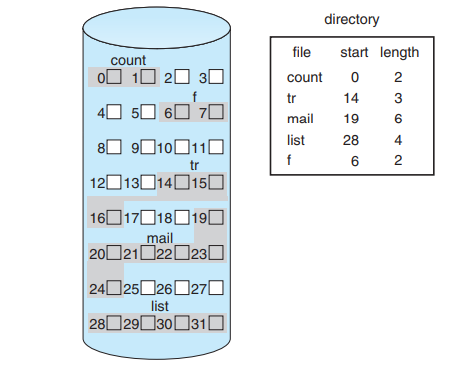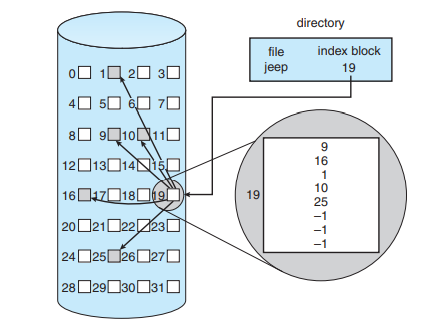Three major methods of allocating disk space are in wide use: contiguous, linked, and indexed. Each method has advantages and disadvantages. Although some systems support all three, it is more common for a system to use one method for all files within a file-system type
Contiguous Allocation
Contiguous allocation requires that each file occupy a set of contiguous blocks on the disk. Disk addresses define a linear ordering on the disk. With this ordering, assuming that only one job is accessing the disk, accessing block b + 1 after block b normally requires no head movement. When head movement is needed (from the last sector of one cylinder to the first sector of the next cylinder), the head need only move from one track to the next. Thus, the number of disk seeks required for accessing contiguously allocated files is minimal, as is seek time when a seek is finally needed
Contiguous allocation of a file is defined by the disk address and length (in block units) of the first block. If the file is n blocks long and starts at location b, then it occupies blocks b, b + 1, b + 2, …, b + n − 1. The directory entry for each file indicates the address of the starting block and the length of the area allocated for this file

Linked Allocation
Linked allocation solves all problems of contiguous allocation. With linked allocation, each file is a linked list of disk blocks; the disk blocks may be scattered anywhere on the disk. The directory contains a pointer to the first and last blocks of the file.
For example, a file of five blocks might start at block 9 and continue at block 16, then block 1, then block 10, and finally block 25 . Each block contains a pointer to the next block. These pointers are not made available to the user. Thus, if each block is 512 bytes in size, and a disk address (the pointer) requires 4 bytes, then the user sees blocks of 508 bytes
Indexed Allocation
Linked allocation solves the external-fragmentation and size-declaration problems of contiguous allocation. However, in the absence of a FAT, linked allocation cannot support efficient direct access, since the pointers to the blocks are scattered with the blocks themselves all over the disk and must be retrieved in order. Indexed allocation solves this problem by bringing all the pointers together into one location: the index block.
Each file has its own index block, which is an array of disk-block addresses. The ith entry in the index block points to the ith block of the file. The directory contains the address of the index block . To find and read the ith block, we use the pointer in the ith index-block entry
When the file is created, all pointers in the index block are set to null. When the ith block is first written, a block is obtained from the free-space manager, and its address is put in the ith index-block entry

